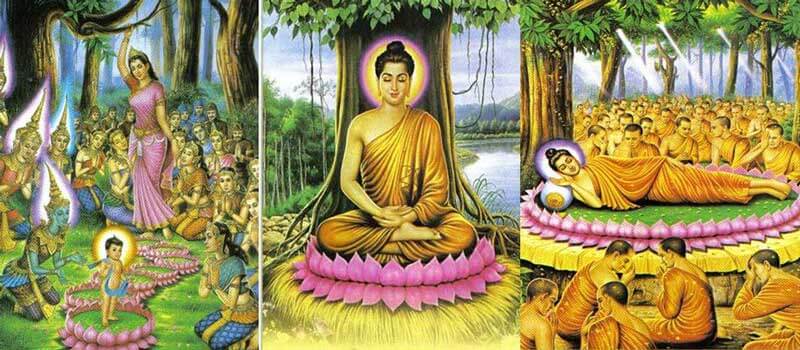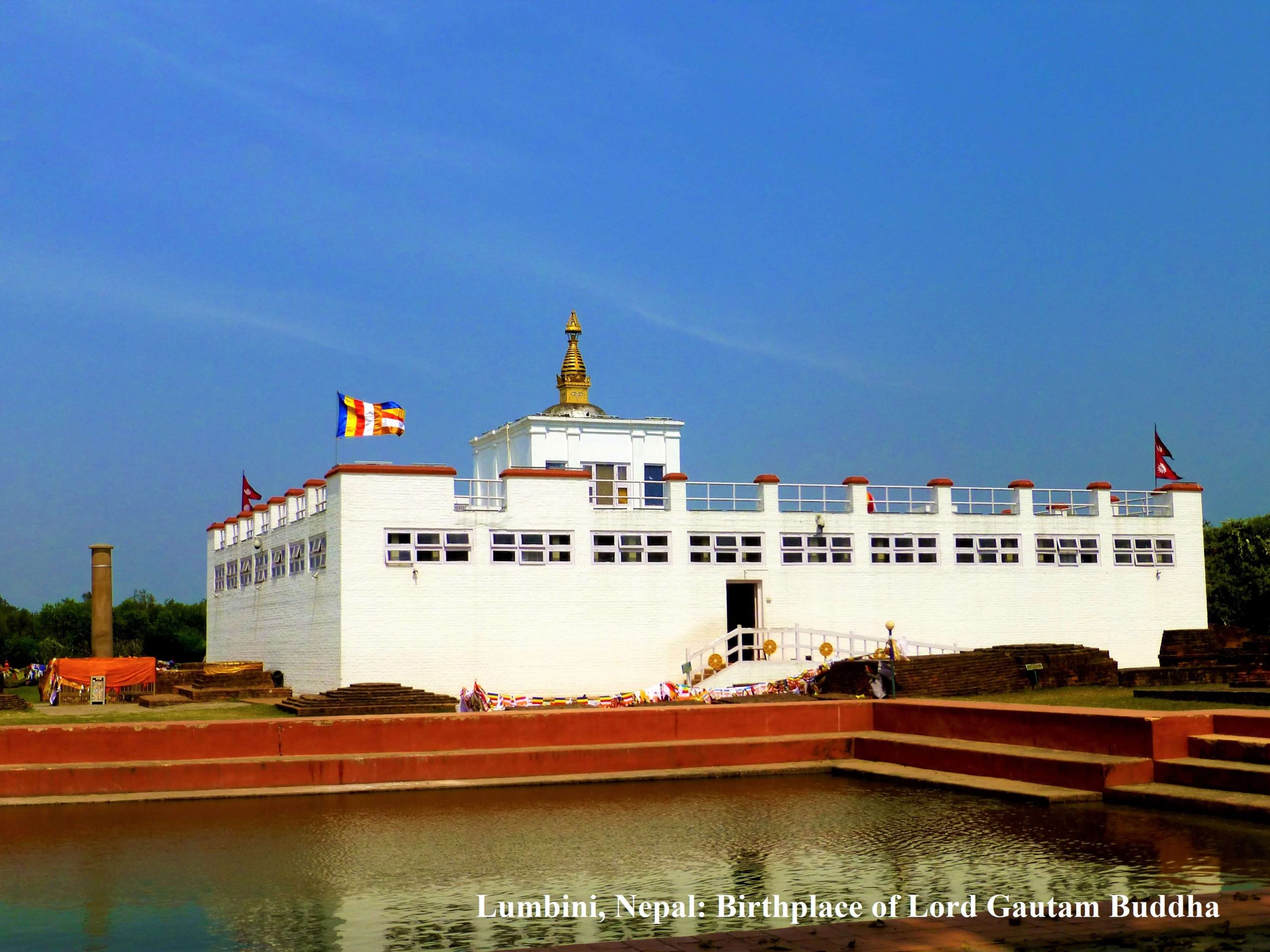Vesak Day: A Day to Commemorate the Buddha

Three major events in the Buddha’s life – birth, enlightenment, and passing away – which constitute the Vesak Day celebration (photo credit: https://bit.ly/3saDrN6)
What is Vesak Day?
Vesak Day, the holiest day in Buddhism, sees the full moon of the month of May, and celebrates the birth, enlightenment (or awakening), and death of the Buddha (known as parinirvana in Pali). It is a celebration that is an expression of gratitude for the legacy that the Buddha left behind — Buddhism — and it can also be a propelling force for us to do good for ourselves and others. Vesak Day is also known by other names, e.g. Buddha Jayanti, Buddha Purnima, and Buddha Day in India, or Visakha Buja Day in Thailand.
Who was the Buddha?
The word “Buddha” means “the Enlightened One” or “the Awakened One.” It is not a proper name but a title given to one who has attained enlightenment, which was what happened to Siddhatha Gotama, who lived more than 25 centuries ago. Siddhatha was born on the full moon day in the month of May in modern-day Nepal as a prince to a royal family of the Sakyan Kingdom, at the foot of the Himalayas. Siddhattha’s father was King Suddhodana, and his mother was Queen Maya. Siddhattha married princess Yasodhara or Bimbadevi or Gopa, his cousin of the same age, who bore him a son, Rahula, at the age of 29.

Archaeological work has uncovered the ancient city of Kapilavastu, now known as Tilaurakot in Nepal (photo credit: https://bit.ly/3KBgYiq)

The Maya Devi Temple (or Lumbini Temple) was built at the place where Prince Siddhattha was born at Lumbini, UNESCO world heritage site (photo by the courtesy of Embassy of Nepal in Bangkok).

Archeological excavations inside and underneath the Maya Devi Temple reveal layers of earlier temples dating from 6th century B.C. (photo credit: https://bit.ly/3MJPKHP)

(Photo credit: https://bit.ly/3vAt3QG)
Since childhood, Siddhattha was very compassionate and clever. He studied the subjects necessary to become a good ruler. In addition, he learned major scriptures in Brahmanism/Hinduism, informing himself of topics such as the Four Vedas, the Six Vedangas, and the Upanishads. He was particularly fascinated with the doctrines of samsara (rebirth or reincarnation), moksha (liberation from the cycle of birth and death), and Atman (self) in the Upanishads. Despite his father’s desire for him to be attached to the world and satisfied with the enjoyment of sensual pleasures, Siddhatha was preoccupied with a desire to solve the problem of samsara, asking: How can one liberate oneself from the cycle of birth or rebirth, which involves death again and again, and how can one help other people to be free from samsara?
Enthusiastically, at the age of 29, Siddhattha asked for his wife’s and father’s permission to leave his family and the palace. He told his wife, “… Though I will be gone, though I will be far away from you, my love for you will remain the same. I will never stop loving you… And when I have found the Way, the answer to his question, I will return to you and to our child.” He also promised his father, “I will never abandon you. I am only asking you to let me go away for a time. When I have found the Way, I will return.” Siddhattha then left his family and became a wandering religious mendicant (Pali: paribbajaka) to find the Way. After six years of studies, including an experiment in the forest inspired by Brahmani ascetism – which he had hypothesized was key – Siddhattha realized that asceticism was not the answer. He gave up ascetic practices, intending for a rational, simple life of moderation instead.
On the night of the full moon in the month of May, forty-five years before the Buddhist Era, Siddhattha, sitting under a peepal tree, underwent great progress in his search, and an omniscient illumination came over him. That night, under the tree, he achieved enlightenment, finally understanding the origins of suffering and rebirth, and how to end it. He said, as quoted in Dr. Hermann Oldenberg’s Buddha: His Life, his Doctrine, His Order, “When I apprehended this, and when I beheld this, my soul was released from the evil of desire, released from the evil of earthly existence, released from the evil of error, released from the evil of ignorance. In the released awoke the knowledge of release: extinct is re-birth, finished the sacred course, duty done, no more shall I return to this world; this I knew.”

Mahabodhi Stupa, a UNESCO World Heritage Site, in the Mahabodhi Temple Complex built to mark the place of the Buddha’s enlightenment in modern-day Bihar (photo credit: https://bit.ly/3LCwwnm)

The main Buddha statue inside the Mahabodhi Stupa (photo credit: https://bit.ly/3y3qQz1)

The fourth generation of the peepal (later called Bodhi) tree under which the Buddha sat on the night of enlightenment is just behind the Mahabodhi stupa (photo credit: https://bit.ly/3KrGcQo)
For the next forty-five years of his life, from the ages of 35 to 80, the Buddha would travel from place to place to teach all who would listen. He organized his followers, who similarly renounced the material world, to form the Sangha.
At the age of 80, however, the Buddha fell ill while on his way to Kusinara (modern-day Kushinagar), capital of the ancient Malla State. In his deathbed under two Sal trees in the Sal Grove of the Mallas, he told his disciples that they would not be left without “the Teacher”: “The Doctrine and Discipline I have taught you, that shall be your teacher when I am gone… Behold now, monks, I exhort you. Subject to decay are all component things. Work out your salvation with diligence.” He passed away on the day of the full moon in the month of May.

The Mahaparinibbana temple (or Mahaparinirvana in Sanskrit and Hindi, on the right) and stupa were built to mark the place of the Buddha’s death at modern-day Kushinagar in Uttar Pradesh, India (photo credit: a Thai Buddhist monk in India)

The statue of dying Buddha inside the Mahaparinirvana Temple at Kushinagar (photo courtesy of Mr. Teeravas Bumpenbunbaramee)
What was the Buddha’s Legacy?
The Buddha’s teachings are his legacy. They are called Dhamma in Pali (Dharma in Sanskrit) and translate to the truth of things – the way things are. It also refers to the teachings that illuminate that truth, detailing the path leading to the direct experience of it.
Examples of the Buddha’s teachings include:
- The Five Precepts
- The Discourse on Prosperity and Happiness (Mangala Sutta in Pali),
- Kamma
- The Four Noble Truths
- The Noble Eightfold Path
- Meditation (you may read how to meditate on Thailandfoundation.or.th here as well).
Following his teachings, believers may find the essence of Buddhism, which is to abandon non-virtuous deeds, to cultivate virtuous deeds, and to purify the mind. One must not be enslaved by negative thoughts and maintain a peaceful and happy mind. (The BBC’s article here, and the scholarly treatise Buddhadhamma: The Law of Natures and Their Benefits to Life by Bhikkhu P.A. Payutto provide easily understandable texts for further reading on Buddhism.)
Celebrating Vesak Day
Vesak Day celebrations may vary in countries. Some Buddhists in India, Indonesia, Japan, Malaysia, Mongolia, Singapore, Sri Lanka, and Vietnam may light candles and put up decorations, while Japanese and Chinese Buddhists may bathe a statue of the Buddha in scented water.

Vietnamese monks during Vesak prayers in Vietnam (photo credit: https://bit.ly/3Ft6e53)

A Buddhist monk releases a lantern at Borobudur temple during celebrations for Vesak Day in Indonesia (photo credit: https://bit.ly/3ycG70h)

Light decoration in Vesak Day celebration in Sri Lankans (photo credit: https://bit.ly/3FdL9v2)

Malaysian Buddhists unfurl a 25-year-old, 196-foot-long devotional painted cloth during Vesak festival celebrations at the Enlightened Heart Tibetan Buddhist Temple in Ipoh, outside Kuala Lumpur, Malaysia, on May 19, 2019 (photo credit: https://bit.ly/3ORvXIk)

Bathing the infant Buddha statue on Vesak Day in Japan (photo credit: https://bit.ly/3saADPS)

Day of Vesak celebrated at the UN Headquarters in New York in 2019 (photo credit: https://bit.ly/38E40mO)
In Thailand, where Vesak Day is known as Visakha Buja Day, Buddhists usually make merit by going to temples, vowing to keep the layman’s precepts, offering food to monks, and listening to Dhamma Talks. And in the afternoon or evening, they may again go to temples to join a procession filled with flowers, incense sticks, and candles, walking around the chapel.

The King of Thailand is celebrating Visakha Bucha Day by walking around the main chapel housing the Buddha at Temple of the Emerald Buddha in Bangkok (photo credit: https://yhoo.it/3ku4L4M)

Thai monks prepare to lead a procession to walk clockwise round a building housing the Buddha image three times at a temple in Thailand on Visakha Bucha Day (photo credit: https://yhoo.it/3MC5Ymm)

Thai Buddhists celebrate Visakha Bucha by circumambulating the main chapel at the Marble Temple in Bangkok (photo credit: https://bit.ly/3s8fnKQ)
However, celebrating Visakha Bucha Day also means making special efforts to bring happiness to the unfortunate and the needy, for instance the aged, the handicapped, and the sick. To this day, Buddhists will distribute gifts in cash and kind to various charitable homes throughout the country.

The Thai Red Cross Society invites people to donate blood on Visakha Bucha Day
(photo credit: https://bit.ly/3MR3PmU)
On Vesak Day this year, I would like to invite readers to join around 500 million Buddhists across the globe in celebrating the Buddha’s birth, enlightenment, and death. By walking on the path to happiness for ourselves as well as for others, practicing compassion for ourselves as well as for others, forgiving ourselves as well as others, we may find a peaceful co-existence with people of different faiths — tolerance and welcome being essential for peace. In this way, we truly celebrate Vesak Day. The Buddha ensures that we can do this; he said, “He is able who think he is able”.
Major references:
- Ajahn Jayasaro. Without and Within: Questions and Answers on the Teachings of Theravada Buddhism. Amarin printing and publishing Plc. 2014.
- Harris, Ian Ph.D. The Complete Illustrated Encyclopedia of Buddhism. HH Hermes House.
Author: Paitoon Songkaeo, Ph.D.
9 May 2022


